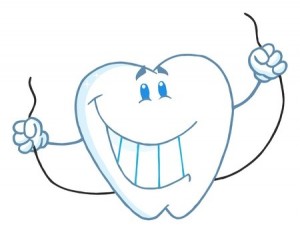Dental Flossing Mastering Instructions
With all of the wonders of modern man available to you there is no better way to clean the sides of your teeth than DENTAL FLOSS; inexpensive, readily available and easy to use. A modern wonder, maybe not. But it is and has always been an excellent tool in the fight against dental decay and periodontal disease. There are many types of dental flossing tools and techniques available in your local drugstore. We recommend waxed flosses, and Glide.
How To Master Your Dental Flossing
You should floss under both sides of each flap of gum tissue between your teeth. The following dental flossing technique has proven to be very effective: break off about 18 inches of floss and wind a good bit of it around one of your middle fingers. Wind the rest around the middle finger of the other hand. Grasp the floss with the thumb and forefinger of each hand, leaving about an inch of floss between the two hands to work with.
 Pull the floss taut and use a gentle sawing motion to insert it between the two teeth. During dental flossing, when the floss reaches the tip of the triangular gum flap, curve the floss into a C shape against one of the teeth. Then slide the floss gently into the space between the tooth and the gum until you feel resistance. Holding the floss tightly against the tooth, scrape up and down five or six times along the side of the tooth. Without removing the floss, curve it around the adjacent tooth and scrape that one too. Repeat on the rest of your teeth. Don’t forget the far sides of your back teeth. When the floss becomes frayed or soiled, a turn of each middle finger brings out a fresh section of floss. After dental flossing rinse vigorously with water.
Pull the floss taut and use a gentle sawing motion to insert it between the two teeth. During dental flossing, when the floss reaches the tip of the triangular gum flap, curve the floss into a C shape against one of the teeth. Then slide the floss gently into the space between the tooth and the gum until you feel resistance. Holding the floss tightly against the tooth, scrape up and down five or six times along the side of the tooth. Without removing the floss, curve it around the adjacent tooth and scrape that one too. Repeat on the rest of your teeth. Don’t forget the far sides of your back teeth. When the floss becomes frayed or soiled, a turn of each middle finger brings out a fresh section of floss. After dental flossing rinse vigorously with water.
Dental Flossing Problems:
If you don’t’ like manipulating dental flossing, try one of the commercial floss holders. They have limited flexibility, however, and you must use them with care to avoid injuring the gum. You may have trouble working with the dental flossing tool between certain teeth, or the floss may consistently break or tear in certain teeth, or the floss may consistently break or tear in certain areas. Several causes are possible, including calculus buildup, or improperly installed fillings.
Please let us know if this problem occurs. Flossing between bridges requires additional instruction and the use of floss threaders. Alternatives to floss include such things as Stimudents, Perio-Aids or Plac-Piks.
Please discuss these dental flossing tools with us before using them. None of these are as good as floss in tight areas between teeth.









